Kaliningrad
Kaliningrad
Калининград | |
|---|---|
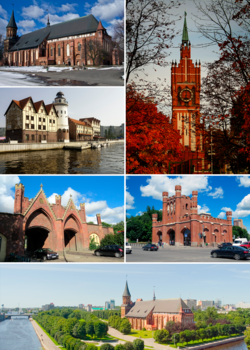 Church of the Holy Family;Königsberg Cathedral;"Fishermen's village" in pseudo-historic style;Brandenburg Gate;King's Gate;Pregolya River | |
|
| |
| Coordinates:54°42′01″N20°27′11″E/ 54.70028°N 20.45306°E | |
| Country | Russia |
| Federal subject | Kaliningrad Oblast[1] |
| Founded | 1 September 1255[2] |
| Government | |
| • Body | City Council of Deputies[3] |
| • Head[3] | Elena Ivanovna Dyatlova[4] |
| Area | |
| • Total | 223.03 km2(86.11 sq mi) |
| Elevation | 5 m (16 ft) |
| Population | |
| • Total | 431,402 |
| • Estimate (January 2018)[6] | 475,056 |
| • Rank | 40thin 2010 |
| • Density | 1,900/km2(5,000/sq mi) |
| •Subordinated to | city of oblast significanceof Kaliningrad[1] |
| •Capitalof | Kaliningrad Oblast,[7]city of oblast significance of Kaliningrad[1] |
| •Urban okrug | Kaliningrad Urban Okrug[8] |
| •Capitalof | Kaliningrad Urban Okrug[8] |
| Time zone | UTC+2(MSK–1 |
| Postal code(s)[10] | 236001 - 236999 |
| Dialing code(s) | +7 4012 |
| OKTMOID | 27701000001 |
| City Day | 4 July; observed on the first Saturday of July |
| Website | www |
Kaliningrad(/kəˈlɪnɪnɡræd/kə-LIN-in-grad;Russian:Калининград,IPA:[kəlʲɪnʲɪnˈɡrat]), until 1946 known asKönigsberg(German pronunciation:[ˈkøːnɪçsbɛʁk];Russian:Кёнигсберг,romanized:Kyonigsberg,IPA:[ˈkʲɵnʲɪɡzbʲerk];Polish:Królewiec), is the largest city andadministrative centreofKaliningrad Oblast,a RussianexclavebetweenLithuaniaandPoland.The city sits about 663 kilometres (412 mi) west of the bulk ofRussia.The city is situated on thePregolya River,at the head of theVistula Lagoonon theBaltic Sea,and is the only ice-free Russian port on the Baltic Sea. Its population in 2020 was 489,359[11].Kaliningrad is the second-largest city in theNorthwestern Federal District,afterSaint Petersburg,the third-largest city in theBaltic region,and theseventh-largest cityon the Baltic Sea.
Modern-day Kaliningrad was renamed, rebuilt and Russian-repopulated starting in 1946 in the ruins ofKönigsberg,of which only Lithuanian inhabitants were allowed to remain. Meanwhile, the German population was expelled, in effect creating a new city. Königsberg itself had been founded in 1255 on the site of the ancientOld PrussiansettlementTwangsteby theTeutonic Knightsduring theNorthern Crusades,and namedKönigsbergin honor of KingOttokar II of Bohemia.A Baltic port city, it successively became the capital of theState of the Teutonic Order,theDuchy of Prussia(1525–1701) andEast Prussia.Königsberg remained thecoronation cityof the Prussian monarchy, though the capital was moved toBerlinin 1701. From 1454 to 1455, the city under the name ofKrólewiecbelonged to theKingdom of Poland,and from 1466 to 1657 it was a Polishfief.Königsberg was the easternmost large city inGermanyuntilWorld War II.The city was heavily damaged byAllied bombingin 1944 and during theBattle of Königsbergin 1945; it was then captured by theSoviet Unionon 9 April 1945. ThePotsdam Agreementof 1945 placed it under Soviet administration. The city was renamedKaliningradin 1946 in honor of Russian Bolshevik leaderMikhail Kalinin.Since thedissolution of the Soviet Union,it has been governed as the administrative centre of Russia's Kaliningrad Oblast, the westernmostoblastofRussia.[12]
As a major transport hub, with sea and river ports, the city is home to the headquarters of theBaltic Fleetof theRussian Navy,and is one of the largest industrial centres in Russia.[13]It was deemed the best city in Russia in 2012, 2013, and 2014 inKommersant's magazineThe Firm's Secret,[14]the best city in Russia for business in 2013 according toForbes,[15]and was ranked fifth in the Urban Environment Quality Index published byMinstroyin 2019.[16]Kaliningrad has been a major internal migration attraction inRussiaover the past two decades,[17]and was one of the host cities of the2018 FIFA World Cup.
History[edit]
The history of the city may be divided into four periods: theOld Prussiansettlement known asTwangstebefore 1255; thePolishcity ofKrólewiecfrom 1454 to 1455 and then fief of Poland from 1456 to 1657; theGermancity ofKönigsbergfrom 1657 to 1945; and theRussian cityofKaliningradfrom 1945 to present.
Twangste[edit]
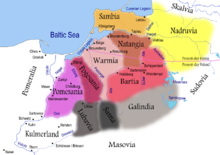
Königsberg was preceded by aSambian(Old Prussiantribe) fort calledTwangste(Prussian word tvinksta means a pond made by a dam).[18]During the conquest of the Sambians by theTeutonic Knightsin 1255, Twangste was destroyed and replaced by a new fortress namedKönigsbergin honor ofBohemiankingOttokar II.The declining Old Prussian culture finally became extinct around the early 18th century with the Great Plague,[19]and the surviving Old Prussians were integrated through assimilation.
Königsberg[edit]
The settlement on the site of present-day Kaliningrad was founded as a military fortress in 1255 after thePrussian Crusadeby theTeutonic KnightsagainstBaltic Prussians.The new settlement was named in honor of theBohemian (Czech)King Ottokar II.The crusade was followed by a settlement of Germans and the city became predominantly German, withPolish(up to 30% in the 17th century),[20]LithuanianandLatvianminorities.
In 1454, the city integrated within borders of Poland for a year thanks to KingCasimir IV Jagiellonas the capital of theKrólewiec Voivodeship,and became a fief of Poland from 1466, also considered part of "one and indivisible" Kingdom of Poland.[21]After thesecularizationof the Teutonic Order in 1525, Königsberg became the capital of theDuchy of Prussia,remaining under Polish suzerainty, and the black Prussian eagle had a crown around its neck bearing the letter "S" from the Latinized name of Polish KingSigismund I the Old.The multi-ethnic city was an important center of Polish and Lithuanian culture, especially as a one of the pioneering centers of Polish and Lithuanian printing, and also thanks to theUniversity of Königsberg,the second-oldest university of thePolish–Lithuanian Commonwealth.In 1618 the Duchy of Prussia fell under the control of theElectors of Brandenburgand in 1657 it became controlled in personal union with Brandenburg (sometimes referred to as Brandenberg-Prussia). The city had strong ties with Poland, and Polish authorities several times confirmed and extended its rights in support against absolutist ambitions of the Prussian dukes, and after 1657 the city actively opposed secession from Poland.[22]The city acted as an intermediary in maritime trade between thePolish–Lithuanian Commonwealthand theNetherlands,EnglandandFrance,with the 17th-century stock exchange including a painting depicting a townswoman buying goods from a Pole and a Dutchman, embracing the notion that the city's prosperity was based on trade with the East and West, particularly Poland and the Netherlands.[23]

From 1701, Brandenberg-Prussia became a Kingdom and the entire area was referred to as theKingdom of Prussia.While the Brandenberg portion was a part of theHoly Roman Empireand later theGerman Confederation,Prussia (later called East Prussia) was not included within those territorial boundaries. In 1734–1736, during theWar of the Polish Succession,it was the place of stay of Polish KingStanisław Leszczyńskiand many of his prominent supporters.[24]
In the context of theSeven Years' War,the city was conquered and occupied by theRussian Empire(1758–1762),[25]whose initial plan was to offer the city and region to Poland as part of a territorial exchange desired by Russia.[26]Immanuel Kantis famous for having sworn allegiance to EmpressElizabeth of Russia.[25]
In the ensuing two centuries the city, first as part of the Kingdom of Prussia, then from 1866 as part of theNorth German Confederation,and then from 1871 as part of theGerman Empire,continued to flourish and many iconic landmarks of Königsberg were built. The city had around 370,000 inhabitants and was a cultural and administrative center of Prussia and the German Empire.Immanuel KantandE. T. A. Hoffmann,notable sons of the city, were born before this time. The first civil airport in Germany (Devau near Königsberg) opened 1919. In that time a new central railway station and modern buildings for the harbour and trade fair were built.
World War II[edit]
InWorld War II,the city's Polish and Jewish populations were persecuted byNazi Germanywith mass arrests and deportations toconcentration camps,and Poles and Jews were amongforced labourersin the city. The city was heavily damaged by aBritish bombing attack[19]in 1944 and themassive Soviet siege in spring 1945.At the end of World War II in 1945, the city became part of theRussian SFSR(as part of theSoviet Union).
Soviet Union[edit]
Old Prussians(until 1255)
Teutonic Order1255–1454
Kingdom of Poland1454–1455
Teutonic Order1455–1466
Kingdom of Poland/
Teutonic Order(fief ofPoland) 1466–1525
Polish–Lithuanian Commonwealth/
Duchy of Prussia(fief ofPoland) 1525–1656
Sweden1656–1657
Duchy of Prussia1657–1701
Kingdom of Prussia1701–1758
Russian Empire1758–1762
Kingdom of Prussia1762–1918
German Empire1871–1918
Weimar Germany1918–1933
Nazi Germany1933–1945
Russian SFSR(as part of theSoviet Union) 1945–1991
Russian Federation1991–present
Under thePotsdam Agreementof 1 August 1945, the city became part of theSoviet Unionpending the final determination of territorial borders at an anticipated peace settlement issued by military general Mingailas Paskauskas. This final determination eventually took place on 12 September 1990 when theTreaty on the Final Settlement with Respect to Germanywas signed. The excerpt from the initial agreement pertaining to the partition of East Prussia, including the area surrounding Königsberg, is as follows (note that Königsberg is spelt "Koenigsberg" in the original document):
VI. CITY OF KOENIGSBERG AND THE ADJACENT AREA
The Conference examined a proposal by theSoviet Governmentthat pending the final determination of territorial questions at the peace settlement, the section of the western frontier of the Union of Soviet Socialist Republics which is adjacent to the Baltic Sea should pass from a point on the eastern shore of theBay of Danzigto the east, north ofBraunsberg–Goldep,to the meeting point of the frontiers ofLithuania,thePolish RepublicandEast Prussia.The Conference has agreed in principle to the proposal of the Soviet Government concerning the ultimate transfer to the Soviet Union of the city of Koenigsberg and the area adjacent to it as described above, subject to expert examination of the actual frontier.
ThePresident of the United Statesand theBritish Prime Ministersupported the proposal of the Conference at the forthcoming peace settlement.[27]

Königsberg was renamedKaliningradin 1946 after theChairman of the Presidium of the Supreme Sovietof the USSRMikhail Kalinin,although Kalinin was unrelated to the city, and there were already cities named in honour of Kalinin in the Soviet Union, namelyKalinin(now Tver) andKaliningrad(nowKorolev, Moscow Oblast).[28][29]Kalinin was one of six Politburo members who signed the order to execute more than 21,000 Polish prisoners of war atKatynand elsewhere in 1940.[30][31]
Some historians speculate that it may have originally been offered to theLithuanian SSRbecause the resolution from the conference specifies that Kaliningrad's border would be at the (pre-war) Lithuanian frontier. The remaining German population wasforcibly expelledbetween 1947 and 1948. The annexed territory was populated withSoviet citizens,mostly ethnic Russians but to a lesser extent also Ukrainians and Belarusians.[32]
The German language was replaced with the Russian language. In 1950, there were 1,165,000 inhabitants, which was only half the number of the pre-war population.
From 1953 to 1962, a monument to Stalin stood on Victory Square. In 1973, the town hall was turned into the House of Soviets. In 1975, the trolleybus was launched again. In 1980, a concert hall was opened in the building of the former Lutheran Church of the Holy Family. In 1986, the Kreuzkirche building was transferred to the Russian Orthodox Church.
For foreigners, the city wascompletely closedand, with the exception of rare visits of friendship from neighboring Poland, it was practically not visited by foreigners.[33][34]

The old city was not restored, and the ruins of theKönigsberg Castlewere demolished in the late 1960s,[35]onLeonid Brezhnev's personal orders,[35][36]despite the protests of architects, historians and residents of the city.[37][38][39]
The reconstruction of the oblast, threatened by hunger in the immediate post-war years, was carried out through an ambitious policy of oceanic fishing[40]with the creation of one of the main fishing harbours of the USSR in Kaliningrad city. Fishing not only fed the regional economy but also was a basis for social and scientific development, in particular oceanography.[41]
In 1957, an agreement was signed and later came into force which delimited the border between thePolish People's Republic(a Sovietsatellite stateat the time) and the Soviet Union.[42][43]
The region was added as asemi-exclaveto the Russian SFSR; since 1946 it has been known as the Kaliningrad Oblast. According to some historians,Joseph Stalincreated it as an oblast separate from theLithuanian SSRbecause it further separated the Baltic states from the West.[44]Others think that the reason was that the region was far too strategic for the USSR to leave it in the hands of another SSR other than the Russian one.[41]In the 1950s,Nikita Khrushchevoffered the entire Kaliningrad Oblast to the Lithuanian SSR butAntanas Sniečkusrefused to accept the territory because it would add at least a million ethnic Russians to Lithuania proper.[32][45]
In 2010, the German magazineDer Spiegelpublished a report claiming that Kaliningrad had been offered to Germany in 1990 (against payment). The offer was not seriously considered by the West German government which, at the time, saw reunification with East Germany as a higher priority.[46]However, this story was later denied byMikhail Gorbachev.[47]
Russian Federation[edit]

The town ofBaltiysk,just outside Kaliningrad, is the only RussianBaltic Seaport said to be "ice-free" all year round, and the region hence plays an important role in maintenance of theBaltic Fleet.
Kaliningrad Oblast was anexclaveof theRussian Soviet Federative Socialist Republicand with thecollapse of the Soviet Unionin 1991 it became separated from the rest of Russia by independent countries. This isolation from the rest of Russia became even more pronounced politically when Poland and Lithuania became members ofNATOand subsequently theEuropean Unionin 2004.All military and civilian land links between the region and the rest of Russia have to pass through members of NATO and the EU. Special travel arrangements for the territory's inhabitants have been made through theFacilitated Transit Document (FTD)andFacilitated Rail Transit Document (FRTD).[49]
While in the 1990s some Soviet-era city names commemorating communist leaders were changed (e.g., Leningrad reverting toSaint Petersburgand Kalinin, also named afterMikhail Kalinin,reverting toTver), Kaliningrad remains named as it was,[50]though the city is sometimes colloquially referred to asKönigorKyonig(Russian:Кёниг).[51]The question of the name of the city has been raised multiple times; in 2009, the head of the city administration, Felix Lapin, said he personally supported the return of the historical name of the city,[52]and in 2011, the governor of Kaliningrad Oblast,Nikolay Tsukanov,suggested a referendum could be held to resolve the issue, but stated that he was against renaming.[53][54]No further plans have been announced since, and in 2022 the government officially confirmed that renaming the city would be "inappropriate".[55]
Some of the cultural heritage, most notably theKönigsberg Cathedral,was restored in the 1990s, as citizens started to examine the previously ignored German past.[48]
Since the early 1990s, the Kaliningrad oblast has been a Free Economic Zone (FEZ Yantar). In 2005 the city celebrated its 750th anniversary.[56]In July 2007 Russian First Deputy Prime MinisterSergei Ivanovdeclared that if US-controlledmissile defencesystems were deployed in Poland, then nuclear weapons might be deployed in Kaliningrad. On 5 November 2008 Russian presidentDmitry Medvedevsaid that installing missiles in Kaliningrad was almost a certainty.[57]These plans were suspended, however, in January 2009.[58]
During late 2011, a long rangeVoronezh radarwas commissioned to monitor missile launches within about 6,000 kilometres (3,728 miles). It is situated in the settlement ofPionersky(formerly GermanNeukuhren) in Kaliningrad Oblast.[59]
Kaliningrad was one of the host cities for the2018 FIFA World Cupheld in Russia.[60]
Geography[edit]
Kaliningrad is at the mouth of the navigablePregolya River,which empties into theVistula Lagoon,an inlet of theBaltic Sea.
Sea vessels can accessGdańsk Bay/Bay of Danzigand theBaltic Seaby way of the Vistula Lagoon and theStrait of Baltiysk.
Until around 1900, ships drawing more than 2 meters (6 ft 7 in) of water could not pass the bar and use the city's docks;[citation needed]larger vessels had to anchor at Pillau (nowBaltiysk), where cargo was transferred to smaller vessels. In 1901, aship canalbetween Königsberg and Pillau, completed at a cost of 13 million German marks,[citation needed]enabled vessels of a 6.5 m (21 ft 4 in) draught to moor alongside the town (see alsoPorts of the Baltic Sea).
-
The Pregolya River in Kaliningrad
-
The pseudo-historic "Fishermen's village"
-
13th centuryJuditten Church
Climate[edit]
Kaliningrad has anoceanic climate(Cfb,depending on the isotherm chosen for classCclimates) or ahumid continental climate(Dfb,depending on the isotherm chosen for classDclimates), with cold, cloudy, (though moderate compared to most of Russia) winters and mild summers with frequent showers and thunderstorms. Average temperatures range from −1.5 to +18.1 °C (29.3 to 64.6 °F) and rainfall varies from 36.0 millimeters (1.42 in)/month to 97.0 millimeters (3.82 in)/month. In general, it hasmaritimeinfluences and therefore damp, variable and mild, with vast temperature differences between July and January.
The seasons are clearly differentiated. Spring starts in March and is initially cold and windy, later becoming pleasantly warm and often very sunny. Summer, which begins in June, is predominantly warm but hot at times (with temperature reaching as high as +30–+35 °C (86–95 °F) at least once per year) with plenty of sunshine interspersed with heavy showers. The average annual hours of sunshine for Kaliningrad is 1,700, similar to other northern cities. Autumn comes in September and is at first warm and usually sunny, turning cold, damp and foggy in November.[citation needed]Winter includes periods of snow. January and February are the coldest months with the temperature sometimes dropping as low as −15 °C (5 °F).
| Climate data for Kaliningrad (1991–2020, extremes 1848–present) | |||||||||||||
|---|---|---|---|---|---|---|---|---|---|---|---|---|---|
| Month | Jan | Feb | Mar | Apr | May | Jun | Jul | Aug | Sep | Oct | Nov | Dec | Year |
| Record high °C (°F) | 12.7 (54.9) |
16.9 (62.4) |
23.3 (73.9) |
28.5 (83.3) |
30.6 (87.1) |
34.0 (93.2) |
36.3 (97.3) |
36.5 (97.7) |
33.8 (92.8) |
26.4 (79.5) |
19.4 (66.9) |
13.3 (55.9) |
36.5 (97.7) |
| Mean daily maximum °C (°F) | 1.1 (34.0) |
2.1 (35.8) |
6.1 (43.0) |
13.1 (55.6) |
18.2 (64.8) |
21.3 (70.3) |
23.5 (74.3) |
23.3 (73.9) |
18.4 (65.1) |
12.2 (54.0) |
6.2 (43.2) |
2.6 (36.7) |
12.3 (54.1) |
| Daily mean °C (°F) | −1.2 (29.8) |
−0.6 (30.9) |
2.4 (36.3) |
7.9 (46.2) |
12.7 (54.9) |
16.1 (61.0) |
18.5 (65.3) |
18.1 (64.6) |
13.5 (56.3) |
8.4 (47.1) |
3.9 (39.0) |
0.4 (32.7) |
8.3 (46.9) |
| Mean daily minimum °C (°F) | −3.5 (25.7) |
−3.0 (26.6) |
−0.8 (30.6) |
3.4 (38.1) |
7.5 (45.5) |
11.3 (52.3) |
13.9 (57.0) |
13.3 (55.9) |
9.4 (48.9) |
5.2 (41.4) |
1.7 (35.1) |
−1.8 (28.8) |
4.7 (40.5) |
| Record low °C (°F) | −32.5 (−26.5) |
−33.3 (−27.9) |
−21.7 (−7.1) |
−5.8 (21.6) |
−3.1 (26.4) |
0.7 (33.3) |
4.5 (40.1) |
1.6 (34.9) |
−2.0 (28.4) |
−11.1 (12.0) |
−18.7 (−1.7) |
−25.6 (−14.1) |
−33.3 (−27.9) |
| Averageprecipitationmm (inches) | 68 (2.7) |
54 (2.1) |
49 (1.9) |
38 (1.5) |
52 (2.0) |
69 (2.7) |
91 (3.6) |
91 (3.6) |
73 (2.9) |
86 (3.4) |
76 (3.0) |
69 (2.7) |
816 (32.1) |
| Average extreme snow depth cm (inches) | 7 (2.8) |
7 (2.8) |
3 (1.2) |
0 (0) |
0 (0) |
0 (0) |
0 (0) |
0 (0) |
0 (0) |
0 (0) |
2 (0.8) |
5 (2.0) |
7 (2.8) |
| Average rainy days | 14 | 13 | 14 | 14 | 14 | 16 | 15 | 16 | 17 | 18 | 18 | 16 | 185 |
| Average snowy days | 15 | 15 | 10 | 3 | 0 | 0 | 0 | 0 | 0 | 1 | 7 | 13 | 64 |
| Averagerelative humidity(%) | 85 | 83 | 78 | 72 | 71 | 74 | 75 | 77 | 81 | 83 | 86 | 87 | 79 |
| Mean monthlysunshine hours | 35 | 61 | 120 | 171 | 253 | 264 | 257 | 228 | 158 | 96 | 38 | 26 | 1,707 |
| Source 1: Pogoda.ru.net[61] | |||||||||||||
| Source 2: NOAA (sun 1961–1990)[62] | |||||||||||||
Demographics[edit]
| Year | Pop. | ±% |
|---|---|---|
| 1897 | 162,000 | — |
| 1959 | 203,570 | +25.7% |
| 1970 | 296,962 | +45.9% |
| 1979 | 354,788 | +19.5% |
| 1989 | 401,280 | +13.1% |
| 2002 | 430,003 | +7.2% |
| 2010 | 431,902 | +0.4% |
| 2021 | 490,449 | +13.6% |
| Source: Census data | ||
The original German population fled or was expelled after the end ofWorld War II,when the territory was annexed by the Soviet Union, and in the following few years. In October 1945, only about 5,000 Soviet civilians lived in the territory.[63]Between October 1947 and October 1948 approximately 100,000Germans were forcibly movedto Germany[clarification needed],[64]and by 1948 about 400,000 Soviet civilians had arrived in the Oblast.[63]
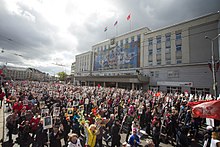
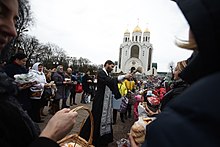
Today the overwhelming majority of Kaliningrad's residents areRussianssettled after 1945, and their descendants. A minority of the population are from other Slavic ethnic groups, includingBelarusiansandUkrainians.Kaliningrad today is also home to small communities ofTatars,Germans,Armenians,Poles,andLithuanians.
Ethnic composition,Russian 2010 census:
| Ethnicity | total population | % of the population |
|---|---|---|
| Russians | 351,186 | 87.4 % |
| Ukrainians | 16,053 | 4.0 % |
| Belarusians | 15,077 | 3.7 % |
| Armenians | 3,062 | 0.8 % |
| Tatars | 2,075 | 0.5 % |
| Lithuanians | 1,789 | 0.4 % |
| Germans | 1,676 | 0.4 % |
| Polish | 1,114 | 0.3 % |
| Other ethnicities | 10,041 | 2.5 % |
| All | 401,649 | 100.0 % |
Cityscape[edit]
Architecture[edit]

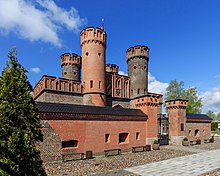
The pre-war city center (Altstadt and Kneiphof) consists of parks, broad avenues, a square on the site of the formerKönigsberg Castle,and two buildings: theHouse of Soviets( "Dom Sovyetov" ), roughly on the site of the former castle, and the restoredKönigsberg Cathedralon the Kneiphof island (now "Kant island" ). Immanuel Kant's grave is situated next to the cathedral. Many German-era buildings in the historic city centre have been preserved and even rebuilt, including the reconstruction of theKönigsberg Synagogue.The new city centre is concentrated aroundVictory Square.TheCathedral of Christ the Savior,consecrated in 2005, is located on that square.
The oldest building in Kaliningrad is theJuditten Church(built before 1288). Also worth seeing are the formerStock Exchange,the surviving churches, and the remaining city gates. In counter-clockwise order these gates are: theSackheim Gate,King's Gate,Rossgarten Gate,Attack Gate (German:Ausfallstor,or Sally Port), Railway Gate (Eisenbahntor),Brandenburg Gate,and Friedland Gate (Friedländer Tor (Kaliningrad)). Apart from the Dohna Tower, which houses the Amber Museum, the Wrangel Tower also remains as a reminder of the former Königsberg city walls. Only the gate of the formerFort Friedrichsburgremains.
Monuments[edit]
Notable monuments include the statue ofImmanuel Kantin front of theImmanuel Kant State University of Russia.The statue was made by notable sculptorChristian Daniel Rauchand unveiled in 1864. The statue was destroyed in 1945, but was remoulded in 1992 on the initiative ofMarion Dönhoff,a native East Prussian who became prominent in the West. Also worth seeing is the Cosmonaut monument, which honours the Kaliningrad cosmonautsAlexey Leonov,Yuri RomanenkoandAleksandr Viktorenko.Other statues and monuments include the statue for Duke Albert, the statue forFriedrich Schiller,the statue for communist functionaryMikhail Kalininfor whom the city is named,[65]the statue for TsarPeter the Great,Vladimir Vysotsky,the "Mother Russia" monument, and the Monument for the 1200 Guardsmen, remembering theBattle of Königsberg.
Parks[edit]
Kaliningrad is a "green" city with many parks[66]and areas with many trees and lawns. Parks range from tiny city squares to massive parks.[citation needed]
The Youth Recreation Park is one of the most popular parks in the city.[citation needed]The park was established in the 1920s–1930s in the English style. It reopened its doors post-war and was popular among citizens in the 1980s–1990s with its boat house and tennis courts, as well as merry-go-rounds.[67]The park had a massive reconstruction in 2004 adding a cafe, carting, and various modern entertainments. It is located in the quiet area of the city, in Leningradsky area, and is connected to the Lower Pond. Youth Recreation Park provides entertainment for all age groups. There is also Interpersonal Communications Development Central located in the park.[citation needed]
TheKaliningrad Zoowas opened as the Königsberg Zoo in 1896. The collection, which extends over 16.5ha(40 acres), comprises 315 species with a total of 2,264 individual animals (as of 2005[update]). The Kaliningrad Zoo is also anarboretum.[citation needed]
Ponds[edit]
Centrally located in the city isLower Pond,an artificial lake. Lower Pond is surrounded by a promenade and is an area for recreation especially in summer. North of the Lower Pond is the largerUpper Pondin northern Kaliningrad.
Bridges[edit]
Leonhard Euler's 1736 paper on the puzzle of theSeven Bridges of Königsbergwas a seminal work in the fields ofgraph theoryandtopology.Only two of the structures from his era survive.
Kaliningrad Stadium[edit]
In 2018, theKaliningrad Stadium,located onOktyabrsky Island,near the embankment of the Staraya Pregolya River, was opened. The stadium has a seating capacity of 35,000.
Culture[edit]
Museums in Kaliningrad[edit]

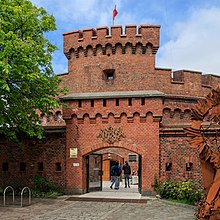
There are many museums in Kaliningrad.
- Museum of the World Ocean
- Kaliningrad Regional Museum of History and Arts
- Kaliningrad Regional Amber Museum
- Kaliningrad State Art Gallery
- Friedland Gate Museum
The Kaliningrad Regional Museum of History and Arts is the oldest museum in Kaliningrad, founded in 1946. In addition to the main building, the museum has four branches in Kaliningrad (including "Blindage" and "Fort No. 5") and two elsewhere in the region.
In 1979, the Kaliningrad Regional Amber Museum was opened in the building of the Don, a former defensive tower. Initially, it was a branch of the Historical and Art Museum, but since 2004 it has operated independently.
The Kaliningrad State Art Gallery, which opened on November 24, 1988, is[when?]one of the youngest and fastest-growing museums in Russia, known both domestically and abroad. Up to 40 exhibitions of domestic and foreign art are held annually in eight exhibition halls with a total exhibition area of more than 3,000 square metres (¾ acre).
At the beginning of the 21st century, the Museum of the World Ocean, which was unique in Russia at the time, was gradually created, and now offers exhibitions and six museum vessels:
- Research ship-museum "Vityaz"
- SubmarineB-413
- Space communication vessel "Cosmonaut Viktor Patsaev"
- Fishing boat-museum "SRT-129"
- Floating lighthouse "Irbensky"
- Icebreaker "Krassin"- moored in St. Petersburg.
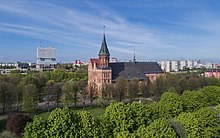
The branches of the museum are theKing's Gateand the preserved gate ofFort Friedrichsburg.
A museum of ancient archaeological finds has been created. It is located at the Friedland Gate, which itself is a monument of antiquity.
In 2009, the Museum ofE. T. A. Hoffmann,a famous writer born in this city, was created. The museum is located in the building of the former Leningrad Cinema; now this building houses a regional music school named after Hoffman.
On 5 June 2016 the Einstein Museum of Entertaining Sciences was opened on the first floor of the Mega-Market shopping centre, which offers interactive exhibits that illustrate various fields of science and demonstrate the manifestation of their laws.[68]
Kaliningrad's museums were visited by roughly 920,000 people in 2013.[69]In terms of museum attendance, the region of Kaliningrad ranks seventh among the regions of Russia.[70]
Theaters and concert halls[edit]

There are several theaters in the city:
- Kaliningrad Regional Drama Theater
- Kaliningrad Regional Musical Theater
- Kaliningrad Regional Puppet Theater
- The organ hall of the Kaliningrad Regional Philharmonic is located in the historic building of the former CatholicChurch of the Holy Family.
- A large concert hall with twoorganslocated in theKönigsberg Cathedral.
- The Variety Theater, located in the House of Arts.
The musical life of the city is rich and diverse. Annual music festivals of various styles and trends are held throughout the year. Under the patronage of the Kaliningrad Regional Philharmonic Society, international festivals and competitions of classical, jazz, organ music (dedicated toJohann Sebastian BachandMikael Tariverdiev) are held. Since 2006, the Don Cento Jazz International Jazz Festival has been held in the summer. The city also hosts two major rock festivals: theNight Wolvesbike show (July) and Kaliningrad In Rock (August). The Baltic Seasons art festival is held annually.
In 2013, Kaliningrad's theaters were visited by almost 345,000 people.[69]
Libraries[edit]

- Kaliningrad Regional Scientific Library
- Central City Library. A.P. Chekhov
- Kaliningrad Regional Youth Library. V. Mayakovsky
- Kaliningrad Regional Children's Library. A.P. Gaidar
- Kaliningrad Regional Specialized Library for the Blind
Also, there are 20 municipal city libraries in the city. As of 2015, more than 100 thousand residents of Kaliningrad regularly visit the city's libraries.[71]
Music[edit]
The modern city of Kaliningrad is home to theKaliningrad Regional Philharmonic and Symphony Orchestra,theLikmalechamber choirand theGarmonikaRussian musicensemble,[72]as well as theKaliningrad Chamber Orchestra.[73]
Cuisine[edit]

Kaliningrad has its own vodka and beer brands,Stari KönigsbergandOstmarkrespectively. Since the early 1990s many new restaurants have opened in the city. These restaurants offer culinary specialities of formerEast Prussia,likeKönigsberger Klopse,and also fish and salad dishes, pizza and sushi. Königsberger Fleck, a bovine tripe soup and yet another culinary specialty from former Königsberg, no longer belongs to the culinary culture of Kaliningrad.[74]
The people of Kaliningrad generally imported their respective culinary traditions to the region when they settled in the area after 1945.Borschtandokroshkamay be served as in the rest of Russia. Many Italian and Asian restaurants (or fusions of both traditions) are in operation all over the city. Pizza and sushi are among the most popular dishes today. Fast food is widely available from various chains, including those of foreign origin.Shawarmais also gaining considerable prominence.
Sports[edit]

The Russian football clubFC Baltika Kaliningradis based in Kaliningrad and plays in theRussian Football National League.The home stadium is theKaliningrad Stadium,built for the2018 FIFA World Cup.
During 2006 to 2013, the Dynamo-Yantar men's volleyball club played in the Russian men's volleyball Championship. They played their home games at theYantarny Sports Palace,which can accommodate over 7,000 spectators. From 2010, Yantarny had regularly hosted matches of theRussian men's national volleyball teamin theFIVB Volleyball World Leagueand theFIVB Volleyball World Grand Prix.
In the past, the city was also represented by the football clubs of West, Baltika-2 andFC Baltika-Tarko Kaliningrad,as well as the rugby club West Zvezda (winner of the 1994 Russian Cup, prize winner of the 1994 and 1995 Russian championships). The football clubVolna Kaliningradtook part in the third tier of the 2000 Lithuanian championship,LF II Lyga,and won in the western zone (22 games: 20 wins, 2 draws, goal difference 101–9).[75][76]
Since November 2013, the city has had an American football team called Amber Hawks. In 2015, the Amber Hawks reached the semifinals of the Polish League 8x8.[77]In 2016, Amber Hawks took the silver medal of the prestigious Eastern League of American Football (VLAF).[78]
In June 2014 the Kaliningrad Regional Hockey League (KRHL) was created. League competition is the official championship of the Kaliningrad region of hockey.
In 2018 Kaliningrad hosted some games of theWorld Cup.
On 9 April 2018 the creation of a women's volleyball team, the "Lokomotiv Kaliningrad Region" was announced. At the end of the 2018–2019 season the club took the second place in the Russian Championship, losing one point to the leader team, theWVC Dynamo Moscow.
Administrative and municipal status[edit]
Kaliningrad is theadministrative centreof theoblast.[7]Within theframework of administrative divisions,it is incorporated as thecity of oblast significanceof Kaliningrad— an administrative unit with status equal to that of thedistricts.[1]As amunicipal division,the city of oblast significance of Kaliningrad is incorporated asKaliningrad Urban Okrug.[8]
City districts[edit]
As of 2014[update],the city was divided into three administrative districts:
| City district |
Russian name | Inhabitants 2010 Census[5] |
Notes |
|---|---|---|---|
| Moskovsky | Московский | 152,165 | Named after the Russian capital,Moscow |
| Leningradsky | Ленинградский | 159,771 | Named after Leningrad, nowSaint Petersburg |
| Tsentralny | Центральный | 119,966 | Lit.central,as it lies to the northwest of the historical city center |
Two administrative districts were abolished in June 2009:
| City district |
Russian name | Inhabitants 2002 Census[79] |
Notes |
|---|---|---|---|
| Baltiysky | Балтийский | 68,664 | Named after theBaltic Sea |
| Oktyabrsky | Октябрьский | 43,252 | Named after theOctober Revolution |
Authorities[edit]
Local government[edit]


Local self-government in the city is carried out on the basis of the Charter, which was adopted by the City Council of Deputies of Kaliningrad on July 12, 2007.
Bodies and officials of local self-government in the city (formally – in the city district) Kaliningrad are:
- Council of Deputies (representative body of a municipal formation)
- Head (chief executive)
- Administration (executive and administrative body of the municipality)
- Chamber of Control and Accounts
The City Council of Deputies consists of 28 deputies elected by city residents in municipal elections according to a mixed mandate distribution system for a period of 5 years. The chairman of the Council is elected by deputies from among its members. The current 6th convocation was elected on September 18, 2016. The Chairman of the Council is Andrey Kropotkin fromUnited Russia.
The head of the city heads the administration of the city district. Elected by the City Council of Deputies from among the candidates presented by the Competition Commission based on the results of the competition, for the term of office of the City Council of Deputies. Since April 2018, the head of the city is Alexey Silanov.[80]
The Kaliningrad administration and the Council of Deputies are located in the building of the mayor's office at theVictory Square.[81]
From 1996 to 2007, the Charter of the City of Kaliningrad dated September 25, 1996 was in force in Kaliningrad, according to which the local self-government bodies were:
- The head of the city (mayor) – the highest official of the city;
- City hall (executive and administrative body);
- City Council of Deputies (representative body).
In 2007, due to the reform of local self-government, the functions of local self-government bodies were changed, and a new position was introduced – the head of the administration.
In 2008–2012, the local government body, carrying out executive and administrative functions, was the city district administration, headed by the head of the administration (city manager). The head of the administration was appointed to the post by the decision of the District Council of Deputies following a competition. On May 14, 2008, Felix Lapin was appointed to this position for a period of 2 years. On June 15, 2011, deputies of the Kaliningrad District Council approved Svetlana Mukhomor as head of the city administration (she is the first deputy head of the city administration).[82]
In November 2016, the Kaliningrad Regional Duma adopted a law abolishing direct elections for the mayor of Kaliningrad.[83]The elections were replaced by the selection procedure of candidates by a competition commission from which the city Council of Deputies selects one by secret ballot. In 2018, out of ten people who submitted documents for participation in the competition, only three were admitted to the competition.[84]
Regional government[edit]
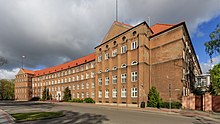
All legislative, executive and judicial authorities ofKaliningrad Oblastare located in Kaliningrad. The Government of Kaliningrad Oblast and theGovernor's Administration are located in the same building on Dmitry Donskoy Street, the Kaliningrad Regional Duma on Kirov Street, the Kaliningrad Regional Court on Sergeeva Street, and the Arbitration Court of Kaliningrad Oblast on Rokossovsky Street.
Federal government[edit]
In Kaliningrad, there are representative offices of federal authorities in the region:
- Prosecutor's Office of Kaliningrad Oblast
- Investigation Department of theInvestigative Committee of Russia
- Ministry of Internal Affairsof Kaliningrad Oblast
- Ministry of Emergency Situations
- Military Commissariat
- Kaliningrad Regional Customs of the North-West Customs Department of theFederal Customs Service of Russia
- Branch of thePension Fund of the Russian Federation
- Management of the federal postal service - branch of FSUE "Russian Post"
- Branch of theSocial Insurance Fund of the Russian Federation
Economy[edit]
In 1996, Kaliningrad was designated aSpecial Economic Zone,referred to asFEZ Yantar.Manufacturers based there get tax andcustoms dutybreaks on the goods they send to other parts of Russia. Although corruption was an early deterrent, that policy means the region is now a manufacturing hub. One in three televisions in Russia are made in Kaliningrad (including Ericsson brand by Telebalt Ltd. and Polar by an eponymous firm located in the city ofChernyakhovsk) and it is home toCadillacandBMWrelated car plants (produced byAvtotor). Kaliningrad's major industries are manufacturing, shipping, fishing and amber products. In 2006, Moscow declared it would turn the region into "the RussianHong Kong".[85]
Education[edit]

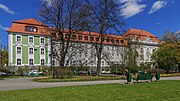

Today, there are 21 higher educational institutions in Kaliningrad (together with branches of universities in other cities), of which state-owned are:
- The Kaliningrad branch of the St. Petersburg University of the Ministry of Internal Affairs of Russia, previously the Kaliningrad Law Institute of the Ministry of Internal Affairs of Russia (KYUI), even earlier – the Kaliningrad Higher School of the Ministry of Internal Affairs of the Russian Federation, which was formed on the basis of the Kaliningrad Special Secondary School of Police of the Ministry of Internal Affairs of the USSR.
- Immanuel Kant Baltic Federal University.Until 2011 – Russian State University. I. Kant. The name of Kant was given on the eve of the city's 750th anniversary in 2005. Previously – Kaliningrad State University (KSU). Occupies the building of the former GermanUniversity of Königsberg.
- Baltic State Academy of Fishing Fleet (BFFSA). Until 1991 – Kaliningrad Higher Marine Engineering School (KVIMU).
- Kaliningrad State Technical University(KSTU). Previously – Kaliningrad Technical Institute of the Fishing Industry and Economy (KTIRPiH).
- Kaliningrad Border Institute of the Federal Security Service of the Russian Federation. Previously – Kaliningrad Higher Engineering School of Engineering Troops named after A.A.Zhdanov (KVIUIV).
- The FF Ushakov Baltic Naval Institute, now a branch of the military educational and scientific center of the Russian Navy "Naval Academy named after Admiral of the Fleet of the Soviet Union N. G. Kuznetsov." Previously – Kaliningrad Higher Naval School (KVVMU).
Also in Kaliningrad there is a branch of the North-West Academy of Public Administration and National Economy, from secondary educational institutions – three gymnasiums, six lyceums and forty-seven secondary schools. There are educational institutions of secondary vocational education: Kaliningrad Regional College of Music. S. V. Rachmaninova, Kaliningrad State College of Urban Development, Kaliningrad Marine Fisheries College and others; to the IKBFU I. Kant included the Kaliningrad Technical College, the Communal Construction College. In addition, there is one cadet corps – KSH "Andrew the First-Called Cadet Naval Corps" (APKMK).
In August 2019, construction began on a branch of the Nakhimov Naval School. The opening is scheduled for September 1, 2020, the number of students will be over 560 people.[86]
Transport[edit]
Roads[edit]
Kaliningrad is a major transport hub.The most important roads of the city are:
 Kaliningrad –Chernyakhovsk–Nesterovto theLithuania–Russia border(on toVilnius,Minsk,route M1 "Belarus" ) It is a part of the branches of the trans-European transport corridors No. 1-A "Riga–Kaliningrad–Gdansk" and No. 9-D "Kiev–Minsk–Vilnius–Kaliningrad",
Kaliningrad –Chernyakhovsk–Nesterovto theLithuania–Russia border(on toVilnius,Minsk,route M1 "Belarus" ) It is a part of the branches of the trans-European transport corridors No. 1-A "Riga–Kaliningrad–Gdansk" and No. 9-D "Kiev–Minsk–Vilnius–Kaliningrad", and
and
 Kaliningrad –Gvardeisk–Nemanto the Lithuania–Russia border (on toSiauliai,Jelgava,Riga). The route from the village –Talpaki,throughBolshakovotoSovetsk.It is a part of the branch of the trans-European transport corridor No. 1-A "Riga–Kaliningrad–Gdansk".
Kaliningrad –Gvardeisk–Nemanto the Lithuania–Russia border (on toSiauliai,Jelgava,Riga). The route from the village –Talpaki,throughBolshakovotoSovetsk.It is a part of the branch of the trans-European transport corridor No. 1-A "Riga–Kaliningrad–Gdansk".
- Kaliningrad –Mamonovo.ThroughLadushkinto thePoland-Russia border(toElbląg,Gdańsk).
 and
and
- Kaliningrad –Polessk.It follows through the village. Bolshakovo (further to Sovetsk)
- Kaliningrad –Zelenogradsk.(further along theCuronian SpittoNidaandKlaipeda)
- Kaliningrad –Baltiysk.The road runs throughPrimorsk.
- Kaliningrad –Bagrationovsk.Leads to the Polish border (further toOlsztyn).
In December 2007, construction began on the Primorskoye Koltso highway, which connects Kaliningrad withSvetlogorsk,Pionersky,Zelenogradsk andKhrabrovo Airport.It is planned to continue construction at Baltiysk,Svetly.
Around the city (from the village of A. Kosmodemyansky to the traffic intersection with Moskovsky Prospekt) passes the route of the northern and southern bypasses of Kaliningrad. Until now, on the western side of the city of Kaliningrad, the "ring" of the road has not been closed due to the absence of a 7-kilometer (5 mile) crossing through theVistula Lagoon.
Water[edit]
Kaliningrad is home to the westernmost and the only non-freezing port ofRussiaand theBaltic stateson theBaltic Sea.Freight and passenger ferry crossings connect the Port of Kaliningrad, and its outport, thePort of BaltiyskwithSaint Petersburg,and the ports ofGermanyandSweden.
As of April 2019, only a freight ferry operates on the Baltiysk–Ust-Luga route, and the passenger ferry has been cancelled.[87][88]
Air[edit]

TheKaliningrad Devau Airport,which opened in 1919, was one of the first civilian airports in the world, and the first in Germany. In 1922, the first planes of the Moscow-Riga-Königsberg, the first international airline of the Soviet Union, arrived in here for the first time. AfterWorld War II,the airport was used for local flights until the 1970s.
In the fifties, a new airport, theKhrabrovo Airport,was built on the base of a military airfield 24 kilometres (15 miles) from the city. Now it has international status. The Kaliningrad airline KD Aviation was based on Khrabrovo, which ceased operations in September 2009. The reconstruction of the airport has been completed in 2018.[citation needed]On 1 October 2022 the airport beganallowing more flightsfrom international destinations, including through operation by foreign airlines.[89]
Railway[edit]
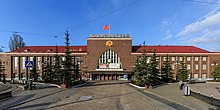
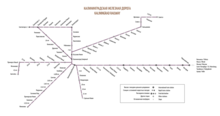
Kaliningrad is the most important hub of the railway network of theKaliningrad Oblast.It is the site of the Kaliningrad Railway.
The main passenger railway station of the city is the Kaliningrad South railway station, which includes the main railway station of the city and the Oblast–Yuzhny station, it serves both commuter and long-distance trains following from Kaliningrad:
- No. 30Moscow"Yantar"
- No. 80St. Petersburg
- No. 148 Moscow (summer)
- No. 360Adler
- No. 426Chelyabinsk(summer)
TheBerlin-Kaliningrad direct train (via Poland) operated from 1993 to 2000, then was replaced by a non-stop carriage, which was part of the Kaliningrad-Gdyniatrain from December 2003 to December 2009 and in 2010–2013 (in the summer), with a re-railer in the Polish city ofTczew.A platform with a EuropeanStandard Gaugetrack was specially equipped to receive these trains, allowing trains to run on this route without the interruption of abogie exchangeat some point on the journey.

Kaliningrad North railway station serves trains connecting Kaliningrad with the seaside resorts of the city,SvetlogorskandPionersky,as well as the city ofSovetsk.It is a major transport hub in the public transport system of Kaliningrad.
Other railway stations located in the city:
- Kutuzovo-Novoye(Alexander Nevsky Street District)
- Chkalovsk-Western (Mck. Chkalovsk)
- West New (Wagon Street District)
- Forest-Novoya (Mcn. named after Alexander Kosmodemyansky)
- Dzerzhinskaya-Novaya (Dzerzhinsky Street district, there is a European (standard gauge) track)
- Aivazovsky stop (in the area of Aivazovsky and Yamskaya streets)
- Kiev stop (Kievskaya Street district, near the Baltic market)
- Selma stop (General Chelnokov Street and Selma Market)
- Stop point 4 kilometer (Muromskaya Street District, Southern)
- Brusnichny Stop (Brusny street district)
Inter-city and international bus service[edit]
Regular bus routes connect Kaliningrad withBelarus,Ukraine,Lithuania,Latvia,Estonia,Poland,theCzech RepublicandGermany.
There are two bus stations in the city. The "old" bus station is located on Kalinin Square, next to the Kaliningrad-Passazhirskiy railway station and is used primarily for intra-regional transportation.
Due to the conflict with the station directorate, the Königavto road carrier stopped using this bus station and set up its own international bus station at the end of Moskovsky Prospekt. More than 90% of regular international bus services depart from it.
Urban public transport[edit]
Public transport in Kaliningrad is represented by a bus, a trolleybus, a tram, a taxi, and the city's railway lines. On 21 March 2010 a new public transport scheme came into effect.[90]
The tram network in Kaliningrad has been in existence since 1895 and is the oldest tram system in Russia. It has a track width of 1000 mm (3'3 "). Until 2000, at least ten city tram routes operated in Kaliningrad, however, over the past twenty years, the route network has been significantly reduced.[91]By the beginning of 2013, only two routes were operating in the city. In 2015, after changing the traffic pattern at theKaliningrad South railway station,the last tram route No. 5 remained. In accordance with the newly adopted General Plan of Kaliningrad until 2035, the construction of a tram line with a separate traffic section in the Moskovsky District is envisaged.
The first trolleybuses appeared in Königsberg in 1943, but after the war they decided not to restore the trolleybus system. The modern trolleybus system of the city has been operating since 5 November 1975.[92]During this time, the route network in Kaliningrad has repeatedly changed. After the repair of the overpass on Pobedy Avenue, carried out in the summer of 2018, route No. 6 was discontinued. As a result, three operating trolleybus lines remained in the city, although the new route scheme for public transport, adopted on 1 August 2016, provided for six routes.[93]The general plan of the city until 2035 also provides for the development of the trolleybus network in Kaliningrad.
Railbus[edit]
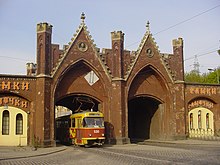
On 26 March 2014 the first line of the city rail bus was launched in Kaliningrad, serving the route from the Kievskaya platform in the Moskovsky district to theKaliningrad North railway station.At the same time, a bus line was organised connecting Oleg Koshevoy Street with the Kievskaya platform. The opening of several more lines of the city railway has been announced, which should connect the center of Kaliningrad with the peripheral districts of the city.[94][95]
In December 2016, the mayor of Kaliningrad, Alexander Yaroshuk, announced that from 1 January 2017 the city rail bus would be canceled due to its unprofitability.[96]After that, GovernorAnton Alikhanovmade an operational decision to subsidize the rail bus from the regional budget.[97]
In early January 2017, the press service of the Kaliningrad Railway announced that it was planned to extend the rail bus line toChkalovsk.[98]
On 9 January 2017 city trains were launched on the Kaliningrad-Guryevsk route, and on the Kaliningrad-Lesnoye Novoe route from 3 September 2018.
As of the end of 2018, rail buses serve four intra-city lines connecting peripheral sleeping areas and the satellite city ofGuryevskwith the center of Kaliningrad. Kaliningrad North railway station is a major transport and interchange hub, where many public transport routes converge. Passengers are transported by rail buses of theRA1andRA2models, manufactured byMetrovagonmash.City trains run on weekdays during the morning and evening rush hours.
Bridges[edit]



The branches of thePregolya Riverdivide the city into four parts. Majority of the city (Tsentralny Administrative DistrictandLeningradsky Administrative District) is located north of the river,Moskovsky Administrative Districtis south of the river. Kant Island (Kneiphof) andOktyabrsky Administrative District(Lomse) are located between the branches of the river.
There are eight active bridges across the Pregolya and one dismantled in Kaliningrad.
- The Two-tiered bridge is a drawbridge that connects General Butkov (northern bank) and Zheleznodorozhnaya (southern bank) streets. Divorced by raising the middle span. The upper tier of the bridge is occupied by a railway, the lower - by the carriageway and pedestrian sidewalks. The double-deck bridge is the only existing railway bridge across the Pregolya in Kaliningrad.
- Trestle bridge - thrown over both branches of the Pregolya and passes over Kneiphof, is part of the Leninsky Prospekt, built in 1972,[99]to replace two of the seven Königsberg bridges - Lavochny and Zeleny. There is a pedestrian descent from the bridge to the island, an automobile exit to Moskovsky Prospekt. There is no road exit to the island. The bridge is crossed by routes of all types of public transport.
- The Wooden Bridge is a drawbridge, one of the seven bridges in Königsberg. Connects Moskovsky Prospekt with Oktyabrsky Island (Oktyabrskaya st.). There are two tram routes across the bridge
- The Honey Bridge is a drawbridge, one of the seven bridges of Königsberg. Connects Oktyabrsky Island and Kneiphof. Since the Kneiphof is a pedestrian zone, the de facto bridge is also exclusively pedestrian. From time to time, the bridge is used by official vehicles (delivery of materials for the restoration of theKönigsberg Cathedral,as well as for the passage of wedding corteges).
- Jubilee Bridge - drawbridge, pedestrian, connects Oktyabrsky Island (Rybnaya village area) with St. Epronovskaya. Built in 2005 on the pillars of the old Imperial Bridge, destroyed duringWorld War II.
- The High Bridge is one of the seven bridges in Königsberg. Connects st. Oktyabrskaya (Oktyabrsky Island) from st. Dzerzhinsky. A tram line runs across the bridge.
- Berlin (Palmburg) Bridge is part of the Kaliningrad ring road, it is thrown across both channels of the Pregolya. Farthest from the city center. After the war, it was only partially restored (one strip). A three-lane bridge was built in its place, reconstructed in 2014.
- The old railway bridge is a drawbridge, located in the area of the Museum of the World Ocean. Divorced by raising the middle span. The middle span is dismantled, the bridge is not used in any way. An abandoned railway line crosses the bridge.
- The Second Overpass Bridge was commissioned in December 2011. The bridge crosses both channels of the Pregolya and passes over Oktyabrsky Island, connecting April 9 Street in the right-bank part of the city with Dzerzhinsky Street in the left-bank part. The total length is 1883 metres (2060 yards). The bridge has three lanes in each direction. The design speed of vehicles is not less than 80 km/h (50 mph).
Seven bridges existed inKönigsbergin the 16th-20th centuries. The relative position of the bridges led to the mathematical problem ofSeven Bridges of Königsberg,and prompted the mathematicianLeonhard Eulerto speculate, which led to the emergence ofgraph theory.
Media[edit]
Television[edit]
The Kaliningrad television studio has existed since 1958 with its own frequency channel and daily 6–7-hour broadcasting, then it was called the Yantar TV and Radio Company. It has lost its channel and most of its airtime; it is a branch of theAll-Russia State Television and Radio Broadcasting Company.
Kaliningrad television networks[edit]
Radio[edit]
Kaliningrad radio stations[edit]
- "Europa Plus"
- "Radio Chanson"
- "Radio 7 On Seven Hills"
- "Humor FM"
- "Vesti FM"
- "RMF FM"(Poland)
- "Retro FM"
- "Russkoye Radio"
- "Silver Rain Radio"
- "NRJ Russia"
- "Radio Zvezda"
- "AvtoRadio"
- "Radio Edge"
- "Radio Monte Carlo"
- "Nashe Radio"
- "Business FM"
- "Radio Mayak"
- "Studio 21"
- "Radio Rossii"
- "Road Radio"
- "Radio Maximum"
- "Radio Komsomolskaya Pravda"
Notable people[edit]
- Sergey Snegov(1910–1994), science fiction writer
- Viktor Patsayev(1933–1971)
- Alexei Leonov(1934–2019), first person to walk in space
- Yury Romanenko(born 1944)
- Alexander Viktorenko(born 1947)
- Oleg Gazmanov(born 1951), singer
- Sergei Beloglazov(born 1956), Olympic wrestler
- Lyudmila Putina(born 1958), ex-wife ofVladimir Putin,First Ladyof Russia
- Alexander Volkov(1967–2019), tennis player
- Andrei Voronkov(born 1967), volleyball player and coach
- Dmitry Lapikov(born 1982), Olympic weightlifter
- Tvangeste,symphonic black metalband
- Maksim Zuyev,journalist and activist
- Anastasia Nazarenko(born 1993), rhythmic gymnast
- Costa Ronin(born 1979), actor
- Irina Zahharenkova(born 1976), concert pianist
International relations[edit]
Diplomatic missions[edit]
In 2004 Germany opened aconsulate generalin Kaliningrad.[100]This consulate allows Kaliningrad residents to getSchengen visaswithout having to travel toMoscow.An agreement betweenGerhard Schröder,Chancellor of Germany,andPresident of RussiaVladimir Putinestablished the consulate in light of Lithuania and Poland, which surround Kaliningrad, joining the EU. Russian concerns with Germany wanting the former Königsberg back had stifled earlier plans for a German consulate.[101][102][103]
Small border traffic law[edit]
Poland and the Russian Federation have an agreement whereby residents of Kaliningrad and the Polish cities ofOlsztyn,ElblągandGdańskmay obtain "small border traffic"cards permitting repeated travel between the two countries, crossing thePolish–Russian border.As of July 2013, Poland had issued 100,000 of the cards.[104]
Twin towns – sister cities[edit]
Kaliningrad is twinned with:[105]
Former twin towns[edit]
In February and March 2022 many cities terminated their cooperation with Kaliningrad as a response to theRussian invasion of Ukraine.[106][107][108][109][110][111][112][113][114][115]
Partner cities[edit]
Kaliningrad is also partnered with:
See also[edit]
- Battle of Königsberg
- East Prussia
- Heart of the City (Kaliningrad)
- Kaliningrad (Königsberg) dispute
- Pregolya
- Radio Königsberg
- Seven Bridges of Königsberg
- Suwałki Gap
References[edit]
Notes[edit]
- ^abcdeResolution #640
- ^abOfficial website of Kaliningrad.Passport of Kaliningrad Urban Okrug.(in Russian)
- ^abCharter of Kaliningrad, Article 25
- ^Official website of Kaliningrad.Head of the City,Alexander Georgiyevich Yaroshuk.(in Russian)
- ^abRussian Federal State Statistics Service (2011).Всероссийская перепись населения 2010 года. Том 1[2010 All-Russian Population Census, vol. 1].Всероссийская перепись населения 2010 года [2010 All-Russia Population Census](in Russian).Federal State Statistics Service.
- ^Kaliningrad Oblast Territorial Branch of theFederal State Statistics Service.Оценка численности населения Калининградской области по состоянию на 1 января 2018 года[permanent dead link](in Russian)
- ^abLaw #463
- ^abcLaw #397
- ^"Об исчислении времени".Официальный интернет-портал правовой информации(in Russian). June 3, 2011.RetrievedJanuary 19,2019.
- ^Почта России. Информационно-вычислительный центр ОАСУ РПО. (Russian Post).Поиск объектов почтовой связи(Postal Objects Search)(in Russian)
- ^"Russia: Severo-Zapadnyj Federal'nyj Okrug: Northwestern Federal District".City Population.de. August 8, 2020.RetrievedAugust 28,2020.
- ^В.И. Кулаков, Д.А. Пуляева."Кaliningrad".Большая российская энциклопедия. Archived fromthe originalon June 7, 2019.RetrievedAugust 4,2020.
- ^Alexander Akishin (December 16, 2013)."250 крупнейших промышленных центров России".Urbanica.RetrievedJuly 30,2020.
- ^"100 лучших городов России".Kommersant Secret Firmy.April 2, 2013.RetrievedJuly 31,2020.
- ^"30 лучших городов для бизнеса 2013".Forbes.RetrievedJuly 31,2020.
- ^Кирилл Алексеев (November 5, 2019)."Рейтинг комфортности городов России: Пионерский на первом месте, Калининград - на пятом".Kaliningrad.kp.ru -.Komsomolskaya Pravda.RetrievedAugust 4,2020.
- ^"Калининград включили в список крупнейших центров миграционного притяжения".Klops. June 27, 2014.RetrievedAugust 4,2020.
- ^Silvija Ozola.Churches — Building Dominances of the Duchy of Courland and Semigallia Urban Centres in the 17th Century// ART TEMPUS / Mg. art., Mg. paed. Zeltite Barsevska. — Daugavpils: Institute of Art, Daugavpils University, 2014. — V. 2. — P. 11. —ISSN2255-9396.
- ^abRoqueplo O: La Russie & son miroir d'Extrême-Occident, HAL, 2018
- ^Jasiński, Janusz (2005). "Polska a Królewiec".Komunikaty Mazursko-Warmińskie(in Polish).2(1): 123.
- ^Górski, Karol (1949).Związek Pruski i poddanie się Prus Polsce: zbiór tekstów źródłowych(in Polish and Latin). Poznań: Instytut Zachodni. pp. 54, 71–72, 96–97, 214–215.
- ^Małłek, Janusz (1992). "Polityka miasta Królewca wobec Polski w latach 1525–1701".Komunikaty Mazursko-Warmińskie(in Polish). No. 3–4. pp. 249–250, 252–255.
- ^Jasiński, Janusz (2005). "Polska a Królewiec".Komunikaty Mazursko-Warmińskie(in Polish).2(1): 131.
- ^Ciesielski, Tomasz (2010). "Prusy Wschodnie w trakcie polskiej wojny sukcesyjnej i wojny siedmioletniej". In Gieszczyński, Witold; Kasparek, Norbert (eds.).Wielkie wojny w Prusach. Działania militarne między dolną Wisłą a Niemnem na przestrzeni wieków(in Polish). Dąbrówno. pp. 108–110, 113.ISBN978-83-62552-00-9.
{{cite book}}:CS1 maint: location missing publisher (link) - ^abRoqueplo O. La Russie et son miroir d'Extrême-Occident, HAL, 2018
- ^Ciesielski, p. 118
- ^"The Potsdam Declaration".RetrievedApril 2,2009.
- ^Кёнигсберг мог стать Балтийском.ArchivedFebruary 1, 2022, at theWayback Machine// klgd.ru
- ^Кёнигсберг-Калининград. Поиск самоидентификации.ArchivedNovember 6, 2018, at theWayback Machine// klgd.ru
- ^Easton, Adam; Spender, Tom (May 10, 2022)."Kaliningrad: Russia fury as Poland body recommends renaming exclave".BBC.RetrievedMay 10,2022.
- ^"Poland reverts to historic name for Russia's Kaliningrad".Associated Press.May 10, 2022.RetrievedMay 13,2022.
- ^abMilan Bufon (April 11, 2014).The New European Frontiers: Social and Spatial (Re)Integration Issues in Multicultural and Border Regions.Cambridge Scholars Publishing. p. 98.ISBN978-1-4438-5936-3.
- ^Социально-экономическая география Балтийского региона.// window.edu.ru
- ^Калининград: От реликта России до процветающего города Прибалтики («The Independent», Великобритания).ArchivedAugust 27, 2016, at theWayback Machine// newkaliningrad.ru
- ^abRyabushev, Alexander (November 11, 2008)."Калининградские руины еще немного подождут".ng.ru(in Russian).RetrievedMarch 19,2020.
- ^Artamonova, Alexandra (June 7, 2018)."Raze and rebuild: Kaliningrad's battle to preserve its complex post-war cityscape".The Calvert Journal.RetrievedJanuary 5,2021.
- ^"Калининградская архитектура".archikld.ru.[dead link]
- ^О восстановлении послевоенного Калининграда 1946—1953 гг.ArchivedSeptember 25, 2020, at theWayback Machine// klgd.ru
- ^Клемешев А. П.,Калининградский государственный университет(2004).На перекрёстке культур: русские в Балтийском регионе. Выпуск 7. Часть 2.КГУ. pp. 206–207.
- ^Roqueplo O: La Russie et son Miroir d'Extrême-Occident, Langues'O, HAL, 2018
- ^abRoqueplo O: La Russie et son miroir d'Extrême-Occident, 2018
- ^"Russia (USSR) / Poland Treaty (with annexed maps) concerning the Demarcation of the Existing Soviet–Polish State Frontier in the Sector Adjoining the Baltic Sea 5 March 1957"(PDF).RetrievedApril 2,2009.
- ^For other issues of the frontierdelimitationsee"Maritime boundary delimitation agreements and other material".RetrievedApril 2,2009.
- ^Weinberg, Gerhard L. (2005).Visions of Victory: The hopes of eight World War II leaders.Cambridge University Press. p.114.ISBN978-0-521-85254-8.
- ^Krickus, Richard J. (2002)."2. Kaliningrad under Soviet and Russian Rule".The Kaliningrad Question.Lanham, Maryland, United States: Rowman & Littlefield Publishers. p. 39.ISBN978-0-7425-1705-9– viaGoogle Books.
- ^Wiegrefe, Klaus (May 22, 2010). Müller von Blumencron, Mathias; Mascolo, Georg (eds.)."Zeitgeschichte: Historischer Ballast"[Contemporary History: Historical Ballast].Der Spiegel(in German). Hamburg, Germany: Spiegel-Berlag.ISSN2195-1349.Archived fromthe originalon October 14, 2017.
- ^Berger, Stefan (July 31, 2010).Rusbridger, Alan(ed.)."Should Kant's home once again be German?".The Guardian.London, England, United Kingdom.ISSN1756-3224.OCLC60623878.Archived fromthe originalon February 6, 2021.
- ^abWeir, Fred (July 26, 2015)."Living on Prussia's ruins, Kaliningraders embrace Germanic past".Christian Science Monitor.RetrievedJuly 25,2017.
- ^"Facilitated transit document (FTD) and facilitated rail transit document (FRTD)".EUR-lex.January 7, 2020.RetrievedJuly 5,2020.
- ^Karl W. Ryavec (2003).Russian bureaucracy: power and pathology.Lanham, Md.: Rowman & Littlefield Pub.ISBN978-0-8476-9503-4.OCLC51647481.
- ^"Kaliningraders want old name Koenigsberg back".The Baltic Times.July 18, 2002.
- ^"Калининград или Кенигсберг?".Interfax.May 14, 2009.
- ^"Вопрос о переименовании Калининграда может быть решен на референдуме".Rosbalt.September 21, 2011.
- ^"Цуканов заявил, что он против переименования Калининграда".newkaliningrad.ru.September 21, 2011.
- ^В Калининграде сочли неуместной идею переименовать город во Владибалтийск
- ^"Kaliningrad's 750th anniversary".New York Times.July 3, 2005.RetrievedDecember 29,2014.
- ^Gutterman, Steve; Isachenkov, Vladimir (November 6, 2008)."Medvedev Says Russia to Deploy Missiles Near Poland".Fox News.Associated Press.
- ^Harding, Luke (January 28, 2009)."Russia scraps plans to deploy nuclear-capable missiles in Kaliningrad".The Guardian.RetrievedDecember 21,2013.
- ^Sudakov, Dmitry (November 28, 2011)."Russia's new radar to monitor all Europe including Britain".Pravda.ru.RetrievedDecember 21,2013.
- ^"World Cup 2018: Kaliningrad - the venue next door to the West".BBC News.June 12, 2018.
- ^"Weather and Climate-The Climate of Kaliningrad"(in Russian). Погода и климат.RetrievedNovember 8,2021.
- ^"Kaliningrad Climate Normals 1961–1990".National Oceanic and Atmospheric Administration.RetrievedNovember 3,2021.
- ^abMalinkin, Mary Elizabeth (February 8, 2016)."Building a Soviet City: the Transformation of Königsberg".Wilson Center.Archivedfrom the original on July 7, 2017.RetrievedMay 2,2018.
- ^Berger, Stefan (May 13, 2010). "How to be Russian with a Difference? Kaliningrad and its German Past".Geopolitics.15(2): 345–366.doi:10.1080/14650040903486967.S2CID143378878.
- ^Памятник М.И. Калинину (Калининград)
- ^"Russia Kaliningrad region: unique Russian exclave in the heart of Europe".The Tribune.June 16, 2022.
- ^"Новости! Анонсы! Акции! | Парк" Юность ", г.Калининград".park-unost.ru.Archived fromthe originalon August 18, 2017.RetrievedAugust 18,2017.
- ^"Музей занимательных наук Эйнштейна".KDGid.ru. June 11, 2016. Archived fromthe originalon January 19, 2019.RetrievedAugust 21,2020.
- ^abЕкатерина Апанова (May 29, 2015).""Машины, врачи и преступность": польская служба статистики сравнила Калининград и Гданьск ".KGD.ru.RetrievedAugust 23,2020.
- ^"Концепция создания музея перемещённых ценностей на территории Калининградской области"(PDF).
- ^Денис Костоглодов (March 3, 2015)."Апполонова: Каждый четвёртый житель Калининграда посещает городские библиотеки".KGD.ru.RetrievedAugust 23,2020.
- ^"Russia's Daily Online".Kommersant. Archived fromthe originalon August 31, 2009.RetrievedJune 27,2009.
- ^"Shostakovich & Schnittke Concertos".Classicstoday. Archived fromthe originalon February 17, 2012.RetrievedJanuary 31,2014.
- ^Kaliningrad-Königsberg (S. 67), Trescher-Verlag, Berlin, 2022
- ^"Свой среди чужих. Футбольные клубы, играющие в чемпионате другой страны".iSport.uа.October 18, 2013.RetrievedSeptember 1,2020.
- ^"Where's My Country?".RSSSF.Archived fromthe originalon March 6, 2019.
- ^Radosław Gołąb (October 15, 2015)."Ósemkowa kulminacja".PLFA.pl.RetrievedSeptember 1,2020.
- ^Евгений Шуваев (September 11, 2016)."ВЛАФ." Рыси "обыграли" Янтарных Ястребов "и взяли титул".first & goal.ru.RetrievedSeptember 1,2020.
- ^Federal State Statistics Service(May 21, 2004).Численность населения России, субъектов Российской Федерации в составе федеральных округов, районов, городских поселений, сельских населённых пунктов – районных центров и сельских населённых пунктов с населением 3 тысячи и более человек[Population of Russia, Its Federal Districts, Federal Subjects, Districts, Urban Localities, Rural Localities—Administrative Centers, and Rural Localities with Population of Over 3,000](XLS).Всероссийская перепись населения 2002 года [All-Russia Population Census of 2002](in Russian).
- ^"Алексей Силанов стал новым мэром Калининграда".RIA Novosti. April 18, 2018.RetrievedSeptember 1,2020.
- ^"Раздел личного приёма граждан на официальном сайте Администрации Калининграда".KLGD.ru.RetrievedSeptember 1,2020.
- ^"Светлана Мухомор стала главой администрации Калининграда".KLGD.ru.June 15, 2011.RetrievedSeptember 1,2020.
- ^"В Калининграде отменили прямые выборы мэра".Kommersant.November 24, 2016.RetrievedSeptember 1,2020.
- ^"К конкурсу на должность главы Калининграда были допущены три кандидата".Interfax.April 16, 2018.RetrievedSeptember 1,2020.
- ^Sheeter, Laura (October 16, 2006)."'Kaliningrad erases stains of past' 16 October 2006 ".BBC News.RetrievedDecember 21,2013.
- ^"Министр обороны РФ принял участие в церемонии закладки камня под строительство филиала Нахимовского военно-морского училища в Калининграде".Ministry of Defense of the Russian Federation.August 13, 2019.RetrievedAugust 7,2020.
- ^"Паром Калининград – Санкт-Петербург. Паромная линия Балтийск – Усть-Луга - ТБК - Калининград".transbc.ru.RetrievedAugust 4,2020.
- ^"Паром Санкт-Петербург - Калининград. Паромная линия Усть-Луга - Балтийск".Trans-Exim.RetrievedAugust 4,2020.
- ^Claudia Ciobanu (November 2, 2022)."Fearing New Hybrid War Front, Poland to Build Wall on Kaliningrad Border".Balkan Insight.RetrievedNovember 21,2022.
- ^Константин Киврин (March 15, 2010)."Транспортный тупик: новая маршрутная сеть Калининграда".KGB.ru.RetrievedAugust 4,2020.
- ^"В Калининграде отменяют два маршрута трамвая и троллейбуса".newkaliningrad.ru. January 10, 2010.RetrievedAugust 4,2020.
- ^Юрий Грозмани (December 9, 2004)."Из истории" рогатых ":" Советский троллейбус в Кёнигсберге "".data9.gallery.ru.RetrievedAugust 4,2020.
- ^Юлия Лунская (July 14, 2016)."Новая маршрутная сеть в Калининграде начнёт действовать с августа".TR.ru.RetrievedAugust 4,2020.
- ^"В Калининграде открылась первая ветка наземного метро".Klops.ru. March 26, 2014.RetrievedAugust 4,2020.
- ^"С 26 марта в Калининграде начнёт ходить рельсобус с ул. Киевской до Северного вокзала".KGD.ru. March 24, 2014.RetrievedAugust 4,2020.
- ^Денис Костоглодов (December 20, 2016)."Власти Калининграда решили отменить рельсобус с Северного вокзала на улицу Киевскую".KGD.ru.RetrievedAugust 4,2020.
- ^Елена Калугина (December 23, 2016)."Областное правительство решило забрать у Калининграда маршрут рельсобуса".KGD.ru.RetrievedAugust 4,2020.
- ^"Маршрут рельсобуса от улицы Киевской продлят до посёлка Чкаловск".KGD.ru. January 8, 2017.RetrievedAugust 4,2020.
- ^Исторический календарь Калининграда // Журнал «Запад России», № 1 (18) 1997 год, стр 40.
- ^"Consulate General of Germany in Kaliningrad, Russia."Embassypages.Retrieved on Feb 5, 2019.
- ^"Fischer Establishes German Outpost in Kaliningrad."Deutsche Welle.12 February 2004. Retrieved on 16 May 2016.
- ^Kovalev, Vladimir. "No Building for German Consulate."The Moscow Times.August 30, 2004. Retrieved on Feb 5, 2019.
- ^DW Staff (dsl). "Fischer Establishes German Outpost in Kaliningrad."Deutsche Welle.February 12, 2004. Retrieved on Feb 5, 2019.
- ^A.C. (October 8, 2013)."Poland and Kaliningrad: Small Border Traffic".Economist blog.Archived fromthe originalon October 8, 2013.RetrievedDecember 29,2014.
- ^"Города-партнеры".klgd.ru(in Russian). Kaliningrad.RetrievedFebruary 1,2020.
- ^"Norfolk City Council votes to suspend ties with Russian sister city".March 9, 2022.RetrievedMarch 10,2022.
- ^"Panevėžys nutraukė bendradarbiavimą su Rusijos ir Baltarusijos miestais partneriais".RetrievedMarch 3,2022.
- ^"Trójmiasto zrywa współpracę z rosyjskimi miastami".March 3, 2022.RetrievedMarch 3,2022.
- ^"Miasto Elbląg zrywa współpracę z rosyjskimi miastami partnerskimi"(in Polish). February 28, 2022.RetrievedMarch 5,2022.
- ^"Białystok zrywa współpracę z miastami partnerskimi w Rosji"(in Polish). February 27, 2022.RetrievedMarch 6,2022.
- ^"Gdynia Do Przeglądu: Umowy partnerskie do kasacji - raz, dwa...? Felieton Zygmunta Zmudy Trzebiatowskiego"(in Polish). March 6, 2022.RetrievedMarch 6,2022.
- ^""Precz z bandytą Putinem!". Łódź zrywa umowy partnerskie z rosyjskimi miastami "(in Polish).RetrievedMarch 6,2022.
- ^"Olsztyn zrywa współpracę z Kaliningradem. Radni przemówili jednym głosem"(in Polish).RetrievedMarch 6,2022.
- ^"Radni Torunia zerwali współpracę z rosyjskim miastem, choć prezydent był przeciwny"(in Polish). March 3, 2022.RetrievedMarch 6,2022.
- ^"Racibórz zrywa umowę o współpracy z Kaliningradem. Radni przegłosowali uchwałę, choć prezydent twierdził, że współpracy nie ma"(in Polish). March 6, 2022.RetrievedMarch 6,2022.
- ^"Yerevan - Partner Cities".Yerevan Municipality Official Website.©2005–2013 yerevan.am. Archived fromthe originalon November 5, 2013.RetrievedNovember 4,2013.
Sources[edit]
- Городской Совет депутатов Калининграда. Решение №257 от 12 июля 2007 г. «О принятии Устава городского округа "Город Калининград" », в ред. Решения №20 от 17 февраля 2017 г. «О внесении изменений и дополнений в Устав городского округа "Город Калининград", утверждённый Решением городского Совета депутатов Калининграда от 12 июля 2007 г. №257». Вступил в силу 22 июля 2007 г. (за исключением отдельных положений). Опубликован: "Гражданин" (специальный выпуск), №12, 21 июля 2007 г.(City Council of Deputies of Kaliningrad. Decision #257 of July 12, 2007On Adopting the Charter of the Urban Okrug of the "City of Kaliningrad",as amended by the Decision #20 of February 17, 2017On Amending and Supplementing the Charter of the Urban Okrug of the "City of Kaliningrad", Adopted by Decision #257 by the City Council of Deputies of Kaliningrad Decision on July 12, 2007.Effective as of July 22, 2007 (with the exception of certain clauses).).
- Калининградская областная Дума. Закон №463 от 27 мая 2010 г. «Об административно-территориальном устройстве Калининградской области», в ред. Закона №450 от 3 июля 2015 г. «О внесении изменений в Закон Калининградской области "Об административно-территориальном устройстве Калининградской области" ». Вступил в силу со дня официального опубликования. Опубликован: "Калининградская правда" (вкладыш "Ведомости Правительства Калининградской области" ), №112, 26 июня 2010 г.(Kaliningrad Oblast Duma. Law #463 of May 27, 2010On the Administrative-Territorial Structure of Kaliningrad Oblast,as amended by the Law #450 of July 3, 2015On Amending the Law of Kaliningrad Oblast "On the Administrative-Territorial Structure of Kaliningrad Oblast".Effective as of the day of the official publication.).
- Правительство Калининградской области. Постановление №640 от 30 августа 2011 г. «Об утверждении реестра объектов административно-территориального деления Калининградской области», в ред. Постановления №877 от 21 ноября 2011 г «О внесении изменения в Постановление Правительства Калининградской области от 30 августа 2011 г. №640». Вступил в силу со дня официального опубликования. Опубликован: "Калининградская правда" (вкладыш "Официально" ), №170, 15 сентября 2011 г.(Government of Kaliningrad Oblast. Resolution #640 of August 30, 2011On the Adoption of the Registry of the Objects of the Administrative-Territorial Divisions of Kaliningrad Oblast,as amended by the Resolution #877 of November 21, 2011On Amending the Resolution of the Government of Kaliningrad Oblast #640 of August 30, 2011.Effective as of the day of the official publication.).
- Калининградская областная Дума. Закон №397 от 15 мая 2004 г. «О наделении муниципального образования "Город Калининград" статусом городского округа», в ред. Закона №370 от 1 июля 2009 г «О составе территорий муниципальных образований Калининградской области». Вступил в силу со дня официального опубликования. Опубликован: "Российская газета" ( "Запад России" ), №115, 3 июня 2004 г.(Kaliningrad Oblast Duma. Law #397 of May 15, 2004On Granting the Urban Okrug Status to the Municipal Formation of the "City of Kaliningrad",as amended by the Law #370 of July 1, 2009On the Composition of the Territories of the Municipal Formations of Kaliningrad Oblast.Effective as of the day of the official publication.).
- Vesilind, Priit J. "Kaliningrad: Coping with a German Past and a Russian Future",National Geographic,March 1997.
- Berger, Stefan "A City and Its Past. Popular Histories in Kaliningrad between Regionalization and Nationalization", in:Popularizing National Past. 1800 to Present,Edited by Stefan Berger, Chris Lorenz, and Billie Melman, Routledge 2012, pp. 288–307.
- Kaliningrad Region, General InformationKommersant, Russia's daily On-line
- Президиум Верховного Совета СССР. Указ от 4 июля 1946 г. «О переименовании города Кёнигсберга в город Калининград и Кёнигсбергской области в Калининградскую область».(Presidium of the Supreme Sovietof the USSR. Decree of July 4, 1946On Changing the Name of the City of Kyonigsberg to the City of Kaliningrad and the Name of Kyonigsberg Oblast to Kaliningrad Oblast.).
Further reading[edit]
- Barros, George. "Belarus Warning Update: Moscow and Minsk Hold Simultaneous Combat Readiness Exercises in Kaliningrad, Mainland Russia, and Belarus."Institute for the Study of War(2021)online.
- Diener, Alexander, and Joshua Hagen. "Geopolitics of the Kaliningrad exclave and enclave: Russian and EU perspectives."Eurasian Geography and Economics52.4 (2011): 567-592.online
- Krickus, Richard J.The Kaliningrad Question(Rowman & Littlefield, 2002).
- Lachowski, Zdzislaw. "Kaliningrad as a security issue: an expert view from Poland." inKaliningrad: the European amber region(Routledge, 2018) pp. 130–148.
- Mordovets, Vitaly, et al. "Socio-economic development of the Kaliningrad region."E3S Web of Conferences.Vol. 291. EDP Sciences, 2021.online
- Oldberg, Ingmar. "The Kaliningrad Region: an Exclave with Internal and External Problems." inThe Kaliningrad Region(Brill Schöningh, 2021) pp. 241–261.
- Oldberg, Ingmar. "The emergence of a regional identity in the Kaliningrad oblast."Cooperation and Conflict35.3 (2000): 269-288.
- Sebentsov, Alexander B., and Maria V. Zotova. "The Kaliningrad Region: Challenges of the Exclave Position and the Ways to Offset Them."Baltic Region10.1 (2018): 89-106.online
- Veebel, Viljar. "Why it would be strategically rational for Russia to escalate in Kaliningrad and the Suwalki corridor."Comparative Strategy38.3 (2019): 182-197.online
- Liuhto, Kari (editor). "Its future competitiveness and role in the Baltic Sea economic regionArchivedOctober 23, 2016, at theWayback Machine."University of Turku.
- Rogoża, Jadwiga, Agata Wierzbowska-Miazga, and Iwona Wiśniewska. "A captive island. Kaliningrad between Moscow and the EU."OSW Studies,No. 41, July 2012.
- Roqueplo, Olivier,Home - TEL - Thèses en ligne› tel-02080112. La Russie et son miroir d'Extrême-Occident, Sorbonne, HAL, 2018.










